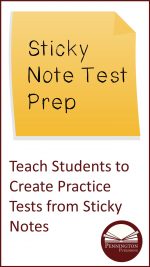How to Take Notes
Taking effective notes can certainly improve comprehension of the information presented in class or found in textbooks. Note-taking can also help organize for test study. However, many students have never learned how to take notes effectively. Indeed, many teachers seem to think that note-taking is a skill learned only by osmosis, and not by direct instruction. A few effective note-taking strategies will help remedy this misconception and enable teachers to teach how to take notes to their students.
Notes are summaries of the main ideas and key details that the teacher wants you to understand and remember. Effective note-taking organizes these summaries so that they can easily be reviewed and practiced. Here are a few key ingredients to effective note-taking:
1. Listen to or read the complete thought. Don’t write something down until you understand it.
2. Learn the signals that your teacher and textbook use to stress main ideas and key details. Some of these signals may be the following:
- repeating key points
- raising the voice to emphasize key points
- spelling key terms
- speaking slowly
- writing key points down
- using phrases such as “key to” “most importantly” “main idea” “in conclusion”
- using transition words such as “first” “next” “finally”
3. Don’t write down everything that the teacher or textbook says. Be selective. If you already know it, don’t write it down.
4. Use your own “shorthand” symbols and abbreviations. Think text messaging!
5. Ask questions about main ideas and key details that you don’t understand.
6. Use a note-taking organizational pattern that fits with the information being presented. A one-size-fits-all note-taking format is not the best approach. Use different formats for different organizational patterns and purposes.
Note-taking Formats
All note-taking formats order information summaries into main ideas, major details, and support details. Each format has advantages and disadvantages depending upon its application and organizational pattern. It is important to know how to use all three of the formats and when each is appropriate. The four most common note-taking formats include formal outline, webbing, Cornell Notes, and margin notes (annotations).
Formal Outline Notes use Roman numerals for main ideas, capital letters for major details, Arabic numerals (1,2,3) for minor details, and even lower case letters for examples. This style of note-taking is well-organized for test study and works well with linear organizational patterns such as chronological, cause-effect, and reasons-for presentations. This style does not fit spatial organizational patterns such as comparison-contrast, relational hierarchies, or recursive (cyclical) patterns.
Webbing is a note-taking style that uses labeled geometric shapes to show relationships between main ideas, major details, and minor details. Usually, the main idea begins the webbing process as a geometric shape in the middle of the notepaper and webs off into different directions for different ideas. Different ideas in outlying webs can be connected to other webs to show relationships. This style of note-taking is not conducive to study because it is messy. However, it does show spatial relationships such as comparison-contrast, relational hierarchies, or recursive (cyclical) patterns that the Formal Outline method can not. Webbing is a wonderful form of brainstorming for essays and narratives.
Cornell Notes is a linear note-taking style that avoids some of the hierarchical organization of the Formal Outline method. It does not use the symbols, but relies on categorization to organize main ideas and supporting details. The notepaper is divided into two columns. The left side serves to list main ideas or ask questions. The right side provides the support details or answers to the questions posed. At the bottom of the notepaper is a horizontal row reserved for personal comments, questions, and analysis.
Margin Notes (also known as annotations or highlighting) have now made their way down into K-12 education from the universities. Thanks to the Common Core State Standards authors’ re-discovery of the Close Reading Method and the re-focus on expository text, most teachers are reducing the amount of short story and novel reading and substituting articles from online sources. Coupled with a renewed interest in Reading Response Theory, teachers are helping students engage and interact with expository text by practicing marginal annotations. This two-way dialogue between reader and author builds comprehension and prepares the student for class discussion. Check out the author’s article, “How Margin Notes are Better than the Yellow Highlighter,” for a nicely-argued rationale for written annotations and suggestions for simple margin symbols. Note: Mark Pennington, the author of this article, has his master’s degree as a reading specialist.
For more practical teaching strategy tips and free teaching resources, please visit penningtonpublishing.com.
The author’s Essential Study Skills is the study skill curriculum that teaches what students need to know to succeed and thrive in school. Often, the reason why
students fail to achieve their academic potential is not because of laziness or lack of effort, but because they have never learned the basic study skills necessary for success.
The 56 lessons in Essential Study Skills will teach your students to “work smarter, not harder.” Students who master these skills will spend less time, and accomplish more during homework and study time. Their test study will be more productive and they will get better grades. Reading comprehension and vocabulary will improve. Their writing will make more sense and essays will be easier to plan and complete. They will memorize better and forget less. Their schoolwork will seem easier and will be much more enjoyable. Lastly, students will feel better about themselves as learners and will be more motivated to succeed. Essential Study Skills is the ideal curriculum for study skill, life skill, Advocacy/Advisory, Opportunity Program classes. The easy-to-follow lesson format of 1. Personal Assessment 2. Study Skill Tips and 3. Reflection is ideal for self-guided learning and practice. Contact the publisher for affordable site licenses.


 Taking tests can be very stressful experiences. The key to
Taking tests can be very stressful experiences. The key to 
